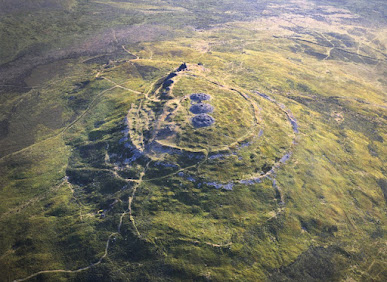I have not made an issue of this before now, but if there were Neolithic quarries buzzing with "industrial scale" activity at Rhosyfelin and Carn Goedog, as MPP would have us believe, why are there no traces at all of "quarrymens' villages"??
This question came into my mind when I did the post yesterday about Foel Drygarn -- a site where thousands of tonnes of stone have been moved and where we can see the source of some of it. The quarry at the foot of the rhyolite crag was the place where stone slabs and lumps were collected from scree and maybe broken from the living rock. But at Foel Drygarn there was a village, with 270 house sites identified by archaeologists. Let's assume that half the houses were occupied at any one time; so 135 dwellings. That means an active population of maybe 270 people, at two per household. That number could have built the Bronze Age burial mounds and the defensive embankments that enclosed the village.
The builders of the fortified settlement on Carningli, who built the very substantial defensive ramparts, must have lived in the Carningli village, where there are many hut traces that have survived to this day. BronzeAge or Iron Age? Maybe some of the traces may be even older.
Other big prehistoric civil engineering projects that would have required large work-forces were also linked to known settlement sites. Think Stonehenge and Durrington, or Newgrange, Knocknerea and Mullaghfarna in Ireland, Carn Brea in Cornwall, or Skarabrae in Scotland. In the Neolithic there were no proper villages, but there were small clustered settlements -- most of them seasonally occupied, but some apparently permanent:
"A Consideration of Villages in Neolithic and Bronze Age Britain and Ireland"Stuart Rathbone
"A Beaker period settlement was found on Ross Island, Co. Kerry, adjacent to the well known early copper mine. Excavations revealed ten or 11 hut foundations, 13 concentrations of stake-holes belong- ing to arrangements of ‘unknown’ type, and plentiful evidence of contemporary metal working activities (O’Brien 2004, 170–303). Occupation at the site began between 2400–2200 BC and perhaps lasted for several hundred years, but it is suspected these structures belong to a single phase within the overall site chronology. O’Brien is careful to call the settlement a work camp, and goes on to stress the transient nature of mining communities (ibid., 303, 475–7). However there was no direct evidence of seasonality and it remains a possibility that this site may be an early mining village."
Back to the so-called Neolithic quarries of Carn Goedog and Rhosyfelin. As we know, Parker Pearson and his fellow researchers were greatly enthused at one stage by the thought that there was a "quarryman's village" at the northernmost edge of the dolerite tor. If the settlement site had turned out to be Neolithic, that would of course have greatly reinforced the quarrying hypothesis, since a quarry dedicated to the extraction and export of monoliths weighing several tonnes must have required a substantial and settled work-force over a considerable period of time. How many workers? Twenty? A hundred? I would go for the latter, since the complexity of the civil engineering processes discussed by MPP et al (including ramps, revetments, platforms, levers and wedges, trackways, storage areas, and so forth) must, if it ever happened, have required substantial organization, team work and muscle power. At Carn Goedog MPP has referred to quarrying "on an industrial scale". Too much purple prose, as usual. But a quarry with a village next door would have made a wonderful addition to the bluestone myth -- and MPP must have been mortified when the "village" turned out to be medieval, and not Neolithic.
https://brian-mountainman.blogspot.com/2016/08/bang-goes-carngoedog-neolithic.html
http://eprints.bournemouth.ac.uk/31410/1/09-Arch_Camb167_Schlee%20et%20al_245-255.pdf
Archaeologia Cambrensis 167 (2018), 245–255Carn Goedog medieval house and settlement, Pembrokeshire
By DUNCAN SCHLEE, RHIANNON COMEAU, MIKE PARKER PEARSON and KATE WELHAM
So my point is this. Quarrying activities, if they ever happened, at Rhosyfelin and Carn Goedog, were so complex, and so invested with spiritual or ritual significance in the MPP narrative that they must have required a settled and dedicated work-force with stone-working skills, living in a tight community. After all, if he refers to quarrying "on an industrial scale" he has to support that claim. The quarry workers and their families must have lived very close to their places of work. No trace of a community or settlement site has ever been found in the vicinity of Carn Goedog or Rhosyfelin. That's not surprising, since the quarries are in any case simply the products of an over-fertile imagination.





No comments:
Post a Comment